Paris doesn’t sleep when the sun goes down-it transforms. The city that dazzles by day becomes something even more magical after dark. Streets glow with soft lamplight, the Seine reflects the shimmer of bridges, and the Eiffel Tower sparkles like a crown of stars. This isn’t just sightseeing. It’s stepping into a living postcard that changes with every hour.
The Eiffel Tower’s Golden Sparkle
Everyone knows the Eiffel Tower. But not everyone has seen it sparkle. Every hour, on the hour, from sunset until 1:00 a.m., the tower bursts into a five-minute display of 20,000 golden lights. It’s not a laser show. It’s simpler, quieter, and far more powerful. The lights don’t flash wildly-they twinkle in slow, synchronized waves, like a heartbeat made of metal and electricity.
Best spot? Head to the Champ de Mars. Bring a blanket, a bottle of wine, and arrive 30 minutes before the first sparkle. You’ll get the full view without the crowds that gather right under the tower. If you’re near the Trocadéro, you’ll get the classic postcard angle with the fountain in front. But the real secret? Walk down to the Pont d’Iéna. You’ll see the tower reflected in the Seine, and if you time it right, a bateau-mouche will glide by with its lights on, doubling the magic.
The Seine River at Midnight
Walking along the Seine after 10 p.m. feels like being inside a movie. The river doesn’t just flow-it glows. The bridges-Pont Alexandre III, Pont Neuf, Pont de l’Alma-are lit in warm gold, their ornate statues catching the light like ancient guardians. The water mirrors everything: the arches, the streetlamps, the occasional couple leaning on the railing, silent and still.
You don’t need a boat ride to feel it. Just walk from Pont Alexandre III to Notre-Dame. The path is lit, safe, and nearly empty after 11 p.m. You’ll pass bookstalls still open, their shelves glowing under umbrellas. You’ll hear distant accordion music from a street performer near Saint-Michel. The air smells like roasted chestnuts and wet stone. This isn’t a tourist trail. It’s Paris breathing.
Montmartre’s Quiet Glow
Montmartre by day is packed. By night, it’s intimate. The crowds thin out after 9 p.m., leaving only those who linger for the view or the music. Climb the steps to the Sacré-Cœur Basilica. The dome is softly lit, and from the terrace, you see Paris spread out like a galaxy of tiny lights. The city doesn’t feel big here-it feels quiet, personal.
Down in the narrow alleys, musicians still play. Not the loud ones near the square, but the ones tucked into corners, playing jazz or chanson with a single microphone and a guitar. One man near Rue des Abbesses plays “La Vie en Rose” every night, rain or shine. He doesn’t ask for money. He just plays. If you stop and listen, he’ll nod at you. That’s Paris.
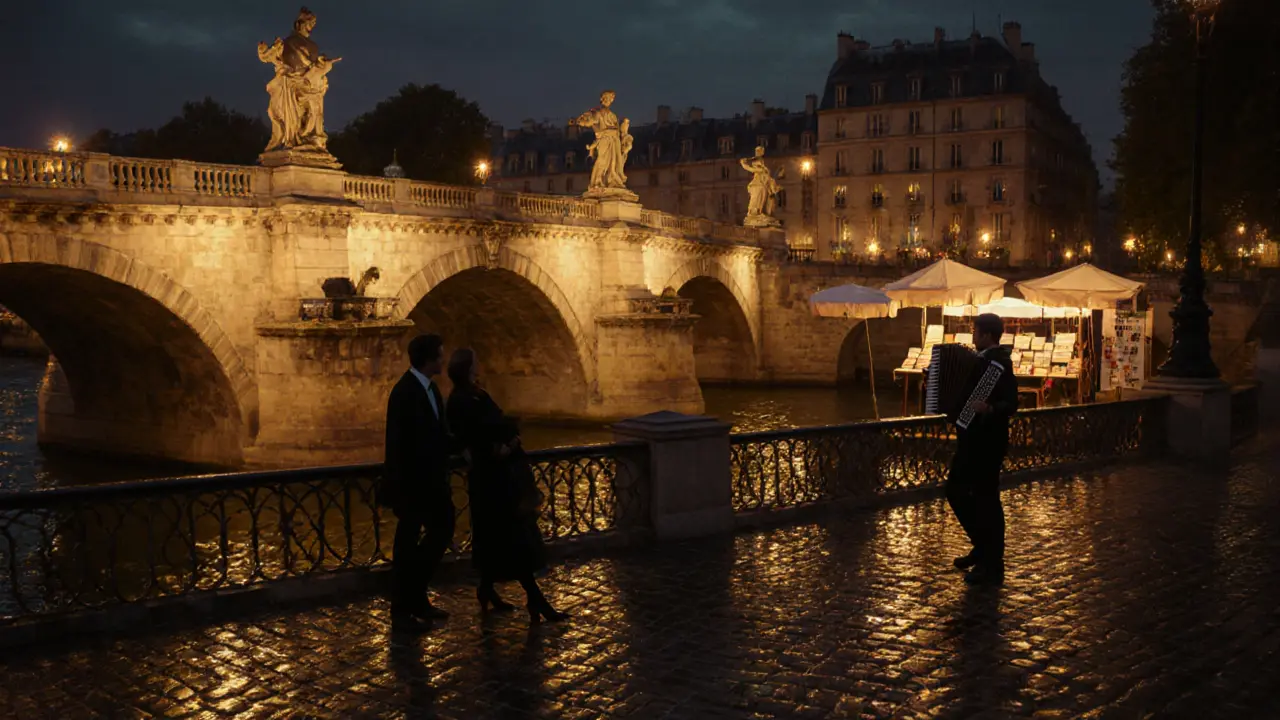
The Lights of Rue de Rivoli
Most tourists miss this stretch. Rue de Rivoli runs from the Louvre to Place de la Concorde, and by night, it’s one of the most elegant avenues in the city. The buildings are lined with classic French architecture, each window softly lit. The streetlights are vintage brass, casting a honey-colored glow on the sidewalks. Cars move slowly. Bicycles glide past. No honking. No rush.
Stop at the corner near the Louvre’s glass pyramid. Look back down the street. The lights stretch into the distance like a ribbon of warmth. This is where Paris feels most alive-not in the clubs, not in the crowds, but in the quiet rhythm of a city that knows how to move gracefully after dark.
Le Marais After Hours
Le Marais is a neighborhood that wears two faces. By day, it’s boutiques and museums. By night, it’s candlelit terraces and hidden courtyards. The streets are cobblestoned and narrow, and the lights come from paper lanterns, wrought-iron signs, and the warm glow spilling from café doors.
Find a spot at La Perle, a tiny wine bar tucked behind Place des Vosges. Order a glass of Beaujolais and sit outside. Watch the locals-older couples sharing dessert, artists sketching in notebooks, friends laughing under string lights. No one is here to be seen. Everyone is here to be present. This is Paris at its most human.
The Nighttime View from Butte-aux-Cailles
Most visitors never make it to Butte-aux-Cailles. It’s a quiet hill in the 13th arrondissement, far from the usual routes. But if you take the metro to Corvisart and walk up the winding streets, you’ll find something rare: a neighborhood that still feels like a village. The buildings are painted in pastels. Graffiti is colorful, not chaotic. And at the top, there’s a small park with a view that few know about.
From here, you can see the Eiffel Tower in the distance, lit up, but also the modern skyline of La Défense glowing faintly on the horizon. The contrast is striking-old Paris and new Paris, side by side, both quiet, both beautiful. You won’t find tour buses here. Just locals with dogs, a few students with sketchbooks, and the sound of wind through the trees.
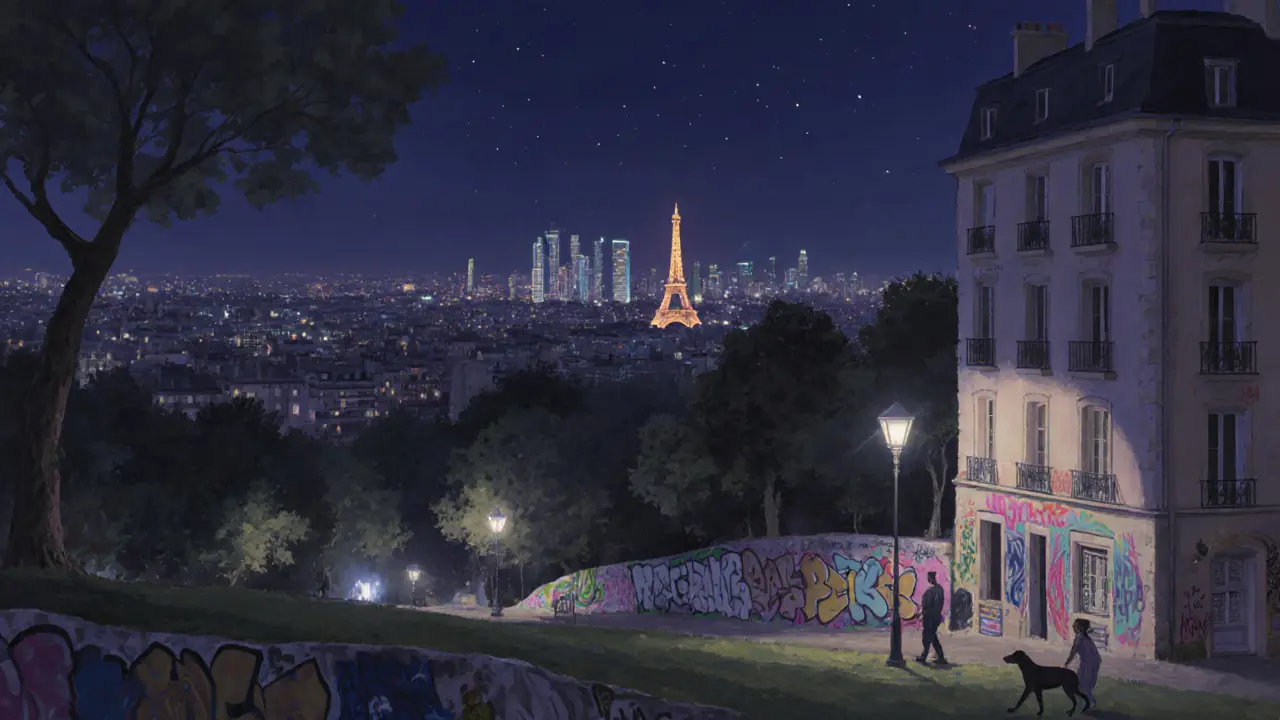
When to Go and What to Wear
Paris at night is never cold, even in winter. But it’s damp. A light wool coat or a trench is enough. Comfortable shoes are non-negotiable. You’ll walk a lot-on cobblestones, on bridges, up hills. No one wears sneakers here, but no one wears heels either. It’s a city that walks with purpose.
Best time to start? Around 7:30 p.m. That’s when the lights come on, and the city begins its slow transformation. The Eiffel Tower sparkles start at sunset, which in October is around 7:45 p.m. End your night with a coffee at a 24-hour boulangerie like Du Pain et des Idées in the 10th. Fresh bread, warm chocolate, and the quiet hum of the city still moving around you.
What Not to Do
Don’t follow the crowds to the top of the Eiffel Tower at night. The lines are long, the view is cramped, and you’ll pay €25 for the privilege of standing shoulder to shoulder. The best views are free, and they’re just a short walk away.
Don’t assume Paris shuts down. Many museums close at 6 p.m., but the city doesn’t. Bistros stay open. Bookshops have late hours. Pharmacies rotate night shifts. You can buy bread, medicine, or a bottle of wine at 1 a.m. if you need to.
And don’t expect music everywhere. Paris at night isn’t a nightclub. It’s a slow, thoughtful rhythm. The music you hear is accidental-a violin from a window, a trumpet from a passing busker, a single voice singing in the metro. That’s the point.
Is Paris safe to explore at night?
Yes, most areas tourists visit at night are very safe. The Eiffel Tower, Seine riverbanks, Montmartre, Le Marais, and the Champs-Élysées are well-lit and patrolled. Avoid isolated side streets in the 18th or 19th arrondissements after midnight, but stick to the main paths and you’ll be fine. Pickpockets exist, so keep your bag closed and your phone in your pocket.
What time do the Eiffel Tower lights sparkle?
The Eiffel Tower sparkles for five minutes every hour, starting at sunset and ending at 1:00 a.m. In October 2025, sunset is around 7:45 p.m., so the first sparkle is at 7:45 p.m., then 8:45, 9:45, and so on until 12:45 a.m. The final sparkle is at 12:45 a.m., not 1:00 a.m.-don’t wait past then.
Can you walk from the Eiffel Tower to Montmartre at night?
Not recommended. It’s about 5 kilometers and takes over an hour. The route passes through busy roads and less populated areas. Take the metro: Line 6 from Bir-Hakeim to Place de Clichy, then walk 10 minutes to Sacré-Cœur. It’s safer, faster, and you’ll save your energy for the views.
Are there any free nighttime attractions in Paris?
Yes. Walking the Seine, viewing the Eiffel Tower sparkle from Champ de Mars, exploring Montmartre’s streets, wandering Le Marais, and sitting in Butte-aux-Cailles park are all free. The Louvre’s exterior and gardens are lit at night and visible from outside. Many churches, like Saint-Eustache and Saint-Germain-des-Prés, stay open until 9 p.m. and are beautifully lit inside.
What’s the best way to experience Paris at night without spending money?
Grab a baguette and cheese from a boulangerie, find a bench along the Seine, and watch the lights reflect on the water. Or sit on the steps of Sacré-Cœur and let the city’s glow wash over you. The magic of Paris at night isn’t in the tickets or the tours-it’s in the silence between the lights.
Next Steps
If you’ve seen these scenes and want more, try the Canal Saint-Martin at midnight-the water is still, the bridges are quiet, and the streetlights cast long shadows. Or visit the Musée d’Orsay’s exterior after closing. The clock face glows against the stone, and the building looks like a cathedral of art.
Paris at night doesn’t shout. It whispers. And if you listen closely, it’ll show you the city’s soul-not the postcard version, but the real one, hidden in the glow of a single streetlamp, the echo of footsteps on stone, and the quiet hum of a city that never stops dreaming.

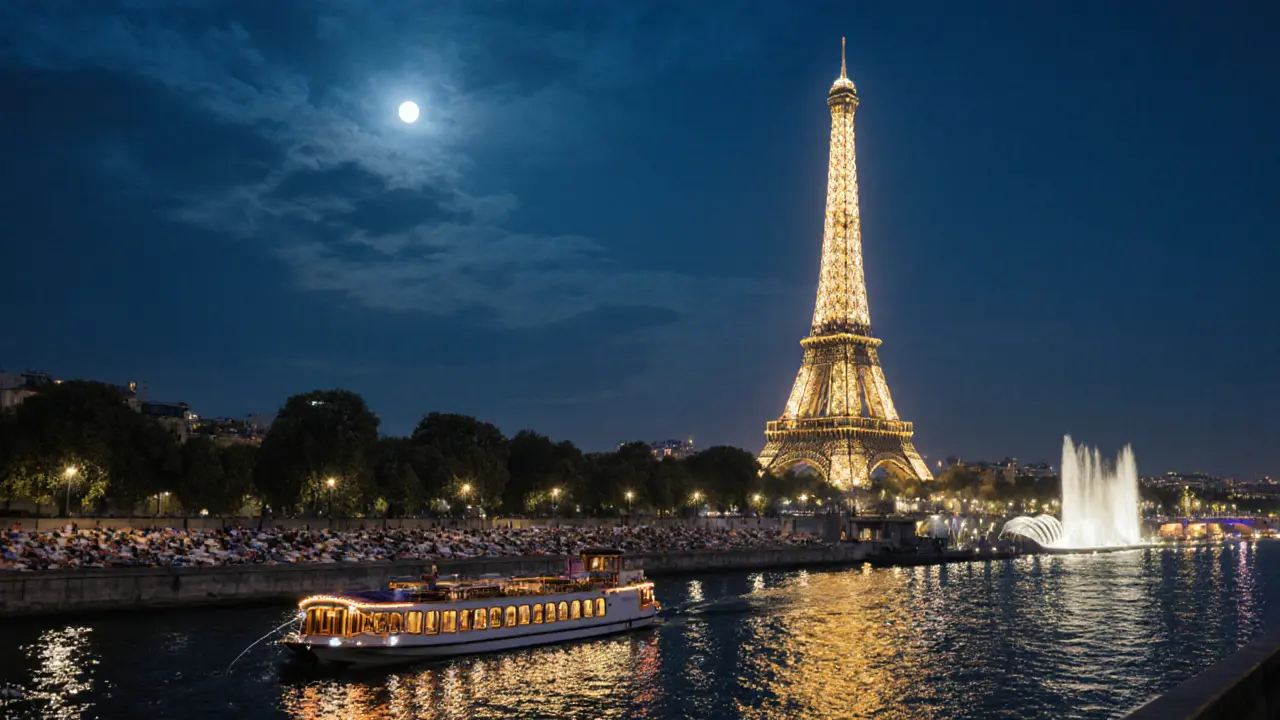
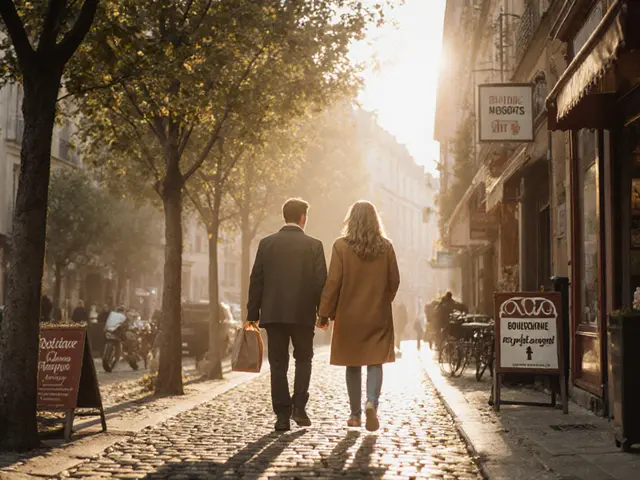
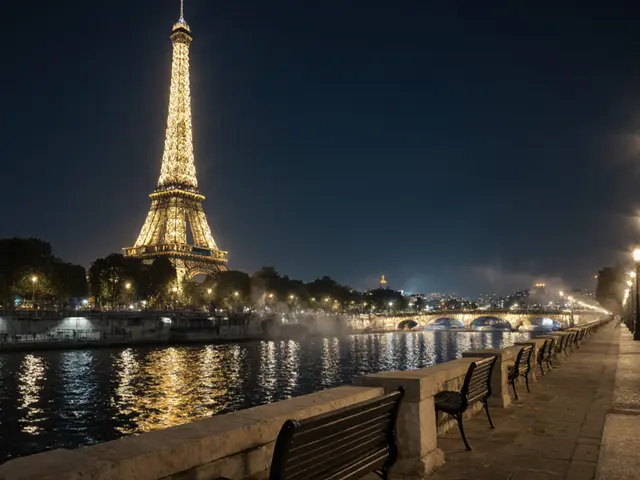

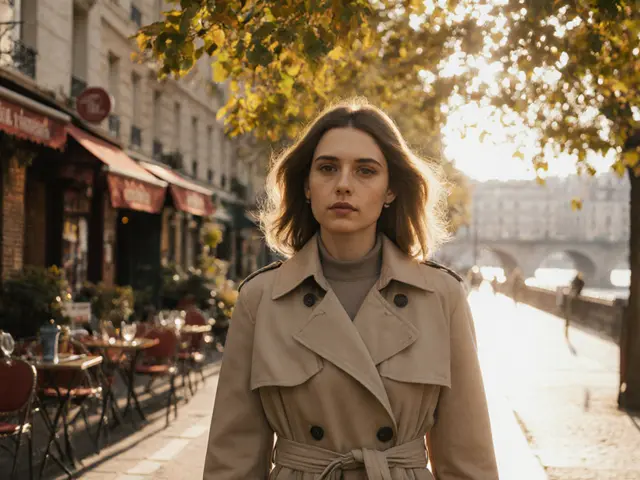
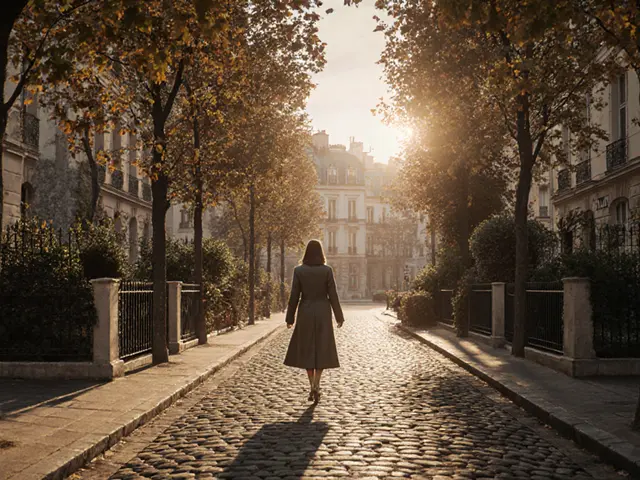
Man, I spent three weeks wandering Paris last winter and this post? It’s like someone reached into my brain and pulled out every quiet moment I didn’t even know I remembered. The way the Seine reflects the bridges at midnight-I sat on a bench near Pont Neuf for an hour just watching the ripples carry the light. No music, no phones, just the sound of someone far off humming. That’s the Paris that sticks with you. Not the Eiffel Tower sparkles-though those are gorgeous-but the way the alley behind La Perle smells like wet wool and old bread at 1 a.m. You don’t go to Paris to see things. You go to feel them. And this? This is the map.
Correction: The Eiffel Tower sparkles end at 1:00 a.m., not 12:45. The last one is at 1:00 a.m. Always. Always. The official website says so. Don’t spread misinformation.
Oh my god. I cried when I read the part about the man playing ‘La Vie en Rose’ on Rue des Abbesses. I was there last March-rain pouring, no one else around-and he looked at me like he knew I’d traveled halfway across the world just to hear it. He didn’t stop. Didn’t smile. Just played. And when I walked away, I didn’t feel like a tourist anymore. I felt like I belonged to the city, even if just for five minutes. Paris doesn’t welcome you. It lets you stay-if you’re quiet enough to listen.
Actually, the Pont Alexandre III lighting isn’t gold-it’s a warm amber with a slight orange cast. The official lighting plan from the City of Paris specifies CRI 90+ LEDs at 2700K. The author’s description is poetic but technically inaccurate. Also, ‘boulevard’ is misspelled as ‘boulevard’ in the Seine section. And why no mention of the lighting schedule for the Louvre’s pyramid? It’s synchronized with the Eiffel Tower’s cycle. This feels like a travel blog written by someone who’s never been.
Thank you for writing this. I’ve been trying to convince my sister to visit Paris for years, and she always says it’s too touristy. This? This is exactly what I wanted to show her. The quiet corners, the hidden musicians, the way the city breathes after dark. I’m sending her this. No words, just this. She’ll get it. And if she doesn’t? Then she’s not ready for Paris yet. But I hope she is. We all need a place that doesn’t shout.
Paris at night isn’t magic-it’s curated. The lights, the music, the ‘authentic’ street performers-they’re all part of a well-oiled tourism machine. The man playing ‘La Vie en Rose’? He’s probably on a contract with the city. The bookstalls? Licensed vendors. The ‘quiet’ alleys? Designed for Instagram. Don’t be fooled. The real Paris is the 3 a.m. metro ride home, the exhausted worker with a baguette, the silent apartment windows. The glitter is just the wrapper. The real soul is the exhaustion underneath. And that? That’s not for tourists.
Pro tip: If you want to experience the true nocturnal rhythm of Paris, avoid the Seine promenade after 11 p.m. on weekends-it’s become a de facto party zone for drunk tourists and local teens. Head to Butte-aux-Cailles instead. The 13th arrondissement is where the real Parisian rhythm lives: low-key, community-driven, and unfiltered. Also, the 24-hour boulangerie recommendation? Du Pain et des Idées is great, but try Boulangerie Utopie in the 10th-they do a killer pain au chocolat that’s actually flaky, not soggy. And yes, the metro is safer than walking from Eiffel to Montmartre. Don’t risk it. Your feet will thank you.
First of all, ‘boulevard’ is misspelled in the first paragraph. Second, the Eiffel Tower doesn’t sparkle ‘every hour on the hour’-it sparkles at 20 minutes past the hour. I’ve timed it. Third, the phrase ‘Paris breathing’ is a cliché so overused it’s practically a tourist trap. And why is no one talking about the fact that Le Marais is now 70% chain stores? The ‘hidden courtyards’? Mostly Airbnb entrances. This post is a fantasy dressed in poetic language. It’s not Paris. It’s a postcard with a filter.
One observation not mentioned: the acoustic properties of Paris at night. The cobblestones, the stone buildings, the narrow alleys-they create a natural reverb that amplifies quiet sounds. That’s why the distant accordion feels so close. Why the footsteps echo longer. Why the silence between the Eiffel Tower’s sparkles feels heavier. This isn’t ambiance. It’s physics. And it’s why Paris at night feels more intimate than any other city. The architecture itself is an instrument. You’re not just seeing it-you’re hearing its resonance.
Look I get it you love Paris but let's be real if you're not drinking wine on a terrace with a view you're doing it wrong. All this quiet walking and listening to street musicians? That's for people who don't know how to have fun. Go out. Dance. Talk to strangers. Paris isn't a library. It's a party that never ends. If you're not laughing at 2 a.m. then you're missing the point. Just saying.